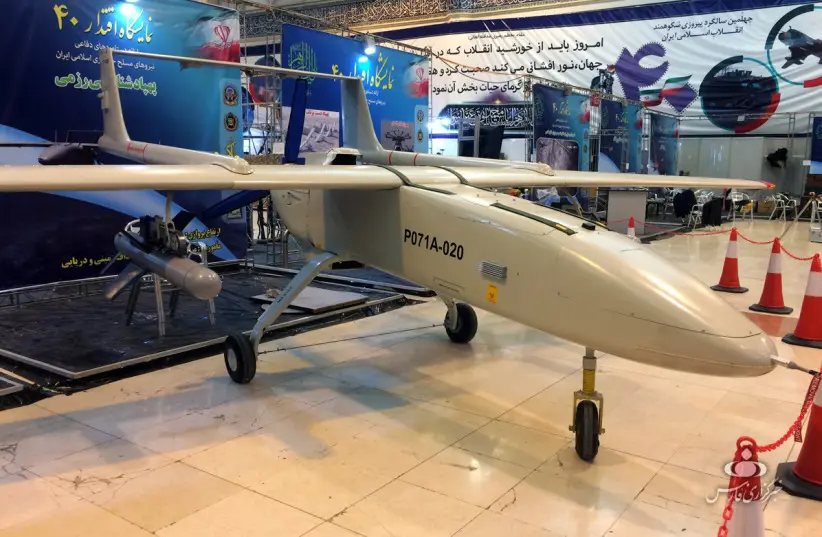HOW WAS A CANADIAN ENGINE USED IN AN IRANIAN DRONE IN UKRAINE?

By: Aaron Reich
Photo: The Jerusalem Post
A Canadian company may have uncovered a complex clandestine supply chain that allowed one of its motors to somehow end up as part of an Iranian drone used by Russian forces in Ukraine, Canada’s National Post reported Thursday.
The company in question is the Quebec-based Bombardier Recreational Products (BRP), which manufactures recreational vehicles like engines, motorcycles, ATVs and snowmobiles. In particular, its Ski-Doo brand of personal snowmobiles is so iconic and beloved in Canada that it was ranked by the Canadian Broadcasting Corporation (CBC) as one of the greatest Canadian inventions back in 2007.
The company is by no means an arms manufacturer or defense contractor, having sold off its military arm in 2003, and its Rotex engine, which is made by its Austrian subsidiary, is intended mainly for civilian use.
However, a report from back in September revealed that an Iranian-made Mohajer-6 drone shot down by Ukrainian forces contained a Rotax 912 airplane engine, the National Post reported.
And this isn’t the only time Rotax engines were found in Iranian drones.
How did a Canadian company’s Rotax engine end up in an Iranian drone used by Russia in Ukraine?
It should be noted that while BRP may not sell engines to Iran or for military use, it wasn’t always that way.
The Canadian firm did, in fact, sell drones to Iran up until ceasing operations in 2019, the National Post reported.
Further, there is a history of Rotax engines being used in drones.
Back in 2020, BRP announced it would stop sending engines to what it dubbed “countries with unclear usage,” which followed reports that Rotax engines were being used in drones utilized by Azerbaijan against Armenian troops during the Nagorno-Karabakh war, the CBC reported at the time.
The company at the time claimed this was something they only just heard of and were unaware their technology was being used in military drones.
The fact that they are being used in drones at all does not stem from their effectiveness, but rather their very cheap price – since they are marketed for civilians – and the fact that, as civilian products, they are not subject to some of the strict arms control export regulations that other products with military applications would have, as experts noted to the CBC.
In Canada, some items are listed as “dual-use” items, meaning they have the potential to be used as weapons or other military-purpose items.
If they also qualify as having clear military uses, they are subject to heavy regulation in both Canada and the European Union, though the EU does not regulate all dual-use items.
Since Rotax engines are made in Austria and not Canada, they are subject to EU export controls, not Canadian, and EU rules are not as specific with regulations regarding engines, Austrian Labor and Economy Ministry spokesperson Alexandra Perl said, according to the CBC.
She further explained that part of these difficulties stems from the logistical impossibility of actually regulating such a broad category. Dual-use is a very broad label and can include everything from engines to smartphones, making regulation for everything outright impossible.
Not just Canada: Western parts found in Iranian drones used in Russia
But regardless, if the Rotax engine in question was still never sold by BRP to Iran or Russia, how did it get there?
This is something the company is being tight-lipped about at the moment, claiming it may jeopardize their investigation, according to the National Post.
However, it should also be noted that this Canadian firm isn’t alone in discovering that somehow its products were being used in Iranian drones in Russia.
In late November, The Wall Street Journal reported that Israeli-made infrared lenses, along with over 200 other components from the US, Europe and other allied nations, have been found in Iranian drones used by Russia in its invasion of Ukraine.
About three-quarters of the components of the drones were American-made while other parts were made by Japanese, Israeli and German firms, along with others, according to Ukrainian documents shown to WSJ by the Kyiv-based nonprofit Independent Anti-Corruption Commission (NAKO).
Israel has long had a hostile diplomatic relationship with Iran and has no exports there, so how did Israeli parts end up in an Iranian drone?
According to The Wall Street Journal report, many of the parts found in the drones are not under export controls and can be easily bought online and shipped through other countries to Iran.
In addition, a SkyNews report from early November claimed that Russia managed to give several advanced stolen Western weapons to Iran. These weapons had originally been sent to the battlefield to help Ukrainian forces, but Russia managed to get its hands on it.
These weapons, along with $140 million, were supposedly sent as payment for a shipment of Iranian suicide drones.
Interestingly enough, some, such as then-opposition leader Benjamin Netanyahu, warned that some weapons sent by the West to Ukraine could end up in Iranian hands.
Both Russia and Iran are under heavy sanctions from the West, and as such often struggle to trade with Western firms.
The exact nature of how Canada’s Rotax engine wound up in Iranian drones in Russia remains to be seen, and it may have to wait until BRP unveils their investigation.




